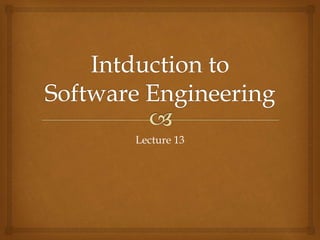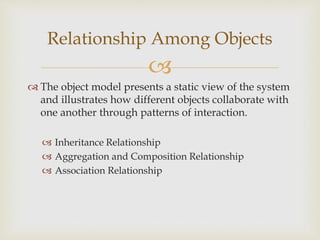Lecture 13
- 1. Lecture 13
- 2. ï ï The Object ï An object can be defined as a tangible entity that exhibits some well defined behavior. An object represents an individual, identifiable item, unit, or entity, either real or abstract, with a well defined role in the problem domain. ï The Class ï The template of an object. A class specifies an interface and defines an implementation. The interface primarily consists of the declaration of all the operations applicable to instances of this class. The implementation of a class primarily consists of the implementation of all the operations defined in the interface of the class Object Oriented Analysis and Design
- 3. ï ï Identity - An Identity can be sub-classed, to include postal and email addresses, telephone numbers, images of faces and logos, and so on. ï State - The state of an object encompasses all of the properties of the object and their current values. ï Behavior - Behavior is how an object acts and reacts in terms of its state changes and message passing. The behavior of an object is completely defined by its actions. An Object
- 4. ï ï The object model presents a static view of the system and illustrates how different objects collaborate with one another through patterns of interaction. ï Inheritance Relationship ï Aggregation and Composition Relationship ï Association Relationship Relationship Among Objects
- 5. ï ï Inheritance defines a âkind ofâ hierarchy among classes. By inheritance, we specify generalization/specialization relationship among objects. In this relationship, a class (called the subclass) shares the structure and behavior defined in another class (called the superclass). A subclass augments or redefines the existing structure and behavior of its superclass. By classifying objects into groups of related abstractions, we come to explicitly distinguish the common and distinct properties of different objects, which further help us to master their inherent complexity. Identifying the hierarchy within a complex system requires the discovery of patterns among many objects. Inheritance Relationship
- 6. ï ï The aggregation relationship defines part-of structure among objects. When object A is part of the state of object B, A is said to be contained by B. There are some tradeoffs between aggregation and association relationships. Aggregation reduces the number of objects that must be visible at the level of enclosing objects and may lead to undesirable tighter coupling among objects. Aggregation and Composition
- 7. ï ï In an association relationship, when object A âusesâ object B, then A may send messages to B. The relationship defines visibility among objects. Association Relationship







